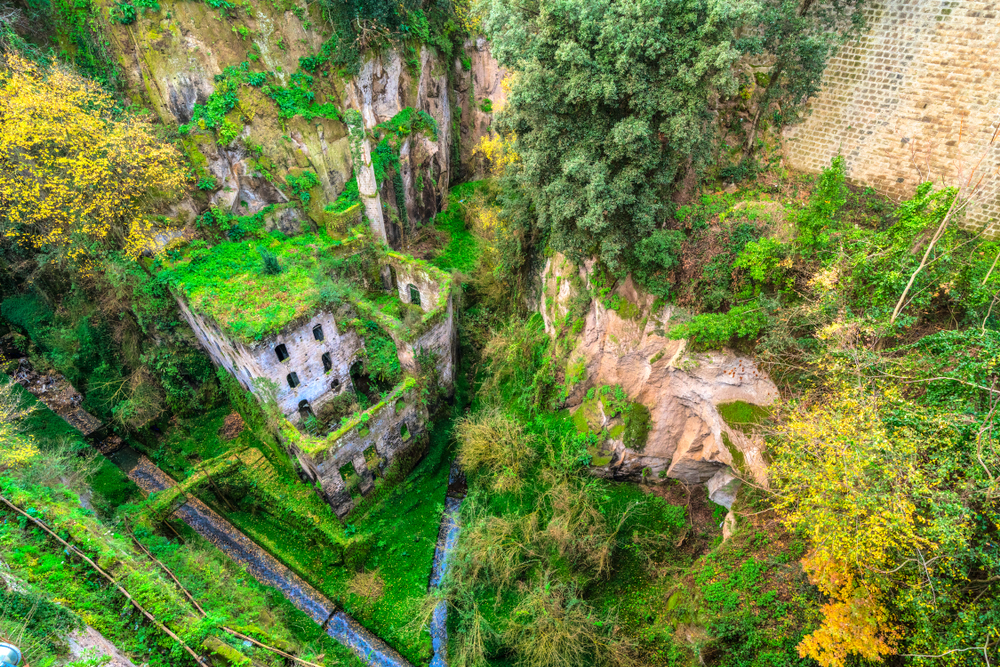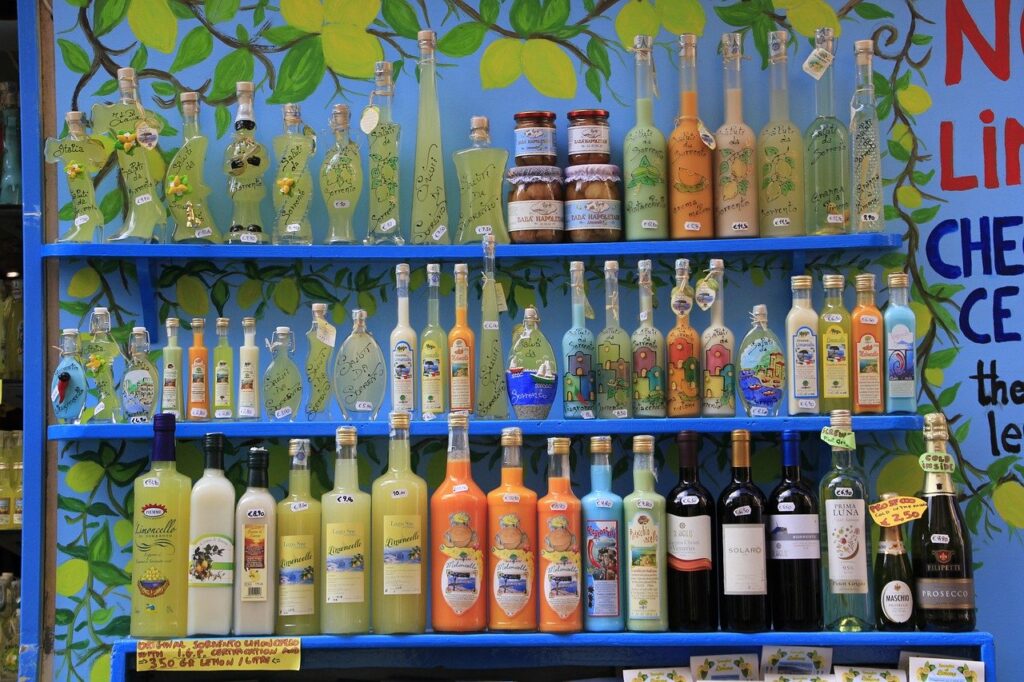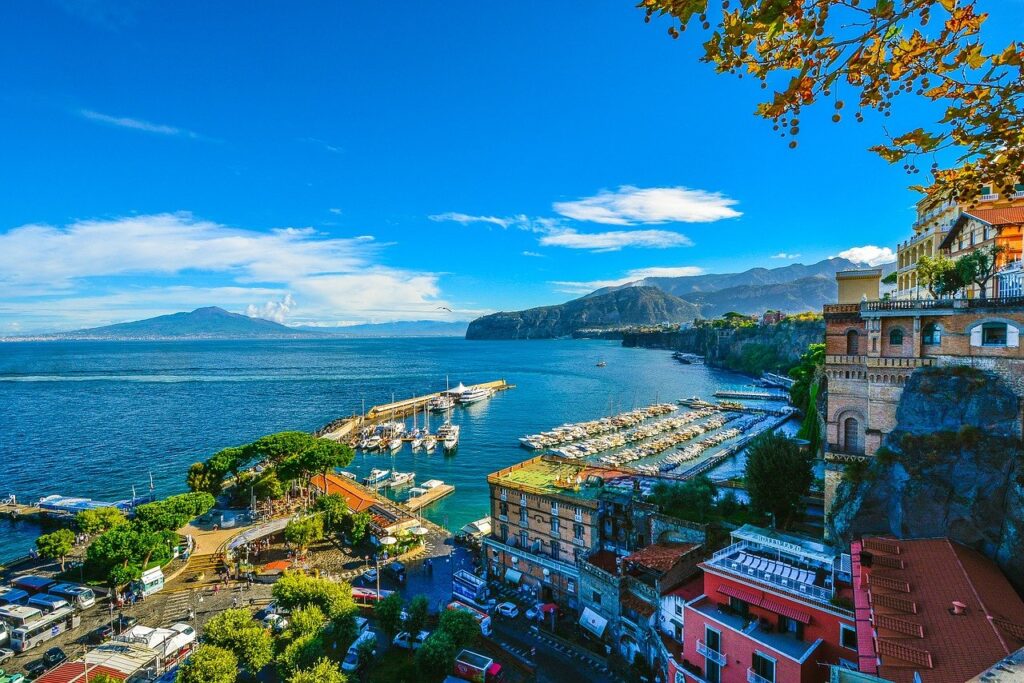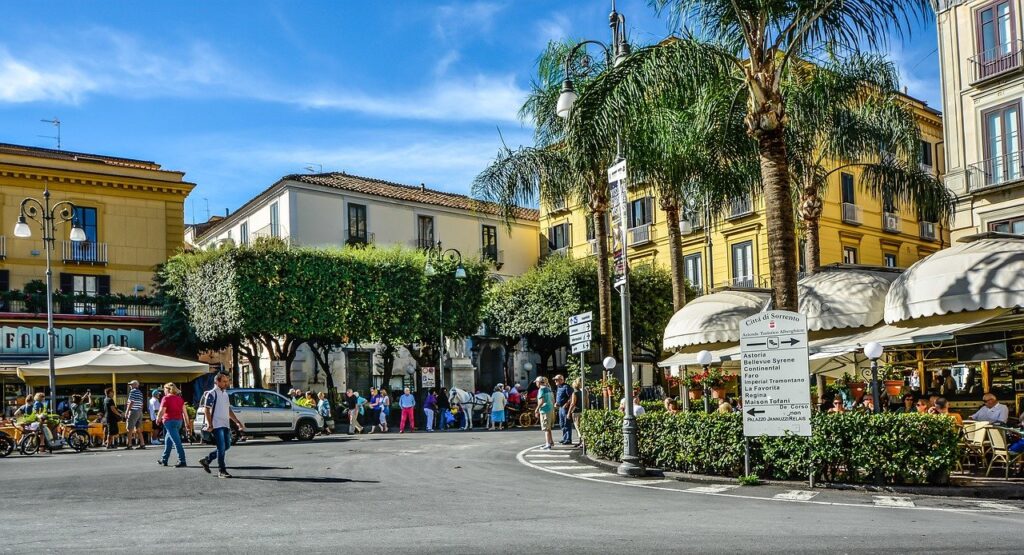Spotlight on Sorrento: Sorrento travel guide
Amalfi Coast, Bookings For You, Inspiration, Italy, Itinerary
Situated an hours drive south of Naples, Sorrento is for us, the gateway to the beautiful Amalfi Coast. This coastline is incredibly picturesque, characterised by pastel-coloured buildings perched upon dramatic cliffs that drop into the crystal clear water below and dotted with lemon and olive groves. A drive along the Amalfi Coast is not for the feint hearted though. This is a road where you’ll quickly lose track of the number of hairpin bends and I challenge anyone to be driven along it without at least once having to close your eyes in fear as buses somehow manage to squeeze past one another on seemingly impossible turns. For many, Sorrento is an excellent base from which to visit a number of other famous nearby attractions including the nearby island of Capri, Pompeii and Mount Vesuvius. However, we think Sorrento deserves a visit in its own right. Here’s our travel guide to Sorrento, perfect for when you’re planning an Amalfi Coast holiday.
What to do in Sorrento
At the heart of Sorrento is the Piazza Tasso, home to a number of bars and restaurants. If you fancy a horse-drawn carriage trip around the town, this is also the place to catch a ride. The square is home to the Baroque Church del Carmine along with a statue of S. Antonino Abbate. The square also leads to Sorrento’s main shopping street – the Via San Cesareo.
From the Piazza Tasso, head to the Via Fuorimura just behind the square where you’ll discover an incredible natural phenomenon – Il Vallone dei Mulino. Whilst you can’t head into the valley itself, the view from above down into the abandoned gorge is quite spectacular and not what you’d expect to come across in the heart of a city. The gorge itself was formed more than 35,000 years ago by a volcanic eruption. Back in the 13th century, it became home to a number of stone flour mills, a sawmill and washhouse however, these were abandoned back in the 1940s when the industry died out. These days, the old buildings are still visible underneath the foliage that has grown over them. It’s quite an eerie and incredible sight.

Also worth a visit is the slightly quieter Piazza Sant’ Antonino. Wherever you go in Sorrento though, you’ll typically find Sorrento’s old town bustling with tourists and a lot less sleepy than many of the other towns along the Amalfi Coast. We love this hustle and bustle though so we would encourage you to embrace it and enjoy its charm. Let’s not forget the thing that Sorrento is arguably most famous for – limoncello. Making use of the rows of lemon groves that line the cliff top terraces in this area, Sorrento is at the very heart of limoncello production so there is no better place to sample this alcoholic tipple when you’re exploring Sorrento’s streets.

Sorrento isn’t without its quieter areas though. The Villa Communale Park park is one of them. This small park also has some fantastic views over Sorrento’s beaches at the Marina Piccola and across the Bay of Naples to Mount Vesuvius. There are plenty of benches where you can sit and enjoy the scene, making the most of the shade provided by the trees and surrounded by the park’s beautiful flowers. There is also a cafe where you can purchase a drink or an ice cream and there is a lift down to the beach and harbour area if you want to see what’s at the bottom of the cliffs. If you can, head to the park just before sunset to marvel at the incredible views. On a clear day, you may even be lucky enough to see Vesuvius’s crater from here. Whilst visiting, also take the time to visit the adjacent 7th century San Francesco cloisters – Chiostro di San Francesco – which are incredibly picturesque and not to be missed.
Sorrento can also boast some beach areas, offering the perfect place to relax and chill out after all that shopping and sightseeing. The picturesque Marina Grande is a small sandy stretch of beach lined with understated family run restaurants serving up fresh fish and local cuisine and dotted with colourful fishing boats and beautiful pastel coloured houses. A visit here will almost feel like stepping back in time. Or, for something a bit different, head to the Bagni Regina Giovanna. Here you’ll find not only a hidden natural swimming pool but also the ruins of a 1st century Roman villa – Villa Pollio Felice. According to legend, this was the favoured spot of Queen Giovanna d’Angio of Naples who in the 14th and 15th centuries, spent hours here with her numerous lovers! The site is accessible on foot from Sorrento and the walk will take you around 40 minutes but we recommend taking the bus. It may be a decent walk but it will also reward you with some wonderful views of the Sorrentine peninsula.

For those in town on a rainy day, why not head to one of Sorrento’s museums. The Museo Correale exhibits collections of 17th and 18th Neapolitan painters along with displays of Capodimonte and Sèvres ceramics, Murano glassware, Bohemia crystals, furnishings and watches. Sorrento’s other museum is the Parco di Villa Fiorentino which also boasts some charming gardens. Or, worth a visit at any time is the Basilica di Sant’ Antonio as well as Sorrento’s 11th century cathedral – the Cattedrale dei Santi Filippo e Giacomo (Cathedral of Saints Philip and James) – home to some incredible frescoes. In December, the cathedral also has a delightful nativity scene well worth seeing.
Events in Sorrento
There are a number of events which take places annually in Sorrento. These usually revolve around religion or music and include:
Festival of Sant’ Antonio: The 7th century Sant’ Antonino is Sorrento’s patron Saint, famous for saving the life of a child swallowed by a whale and protecting the city against plague and invasion. Every February, a silver statue of the saint is carried through the streets and his death is marked by processions, fireworks and music. This is very much party time in the city!
Easter Week (Settimana Santa): This time of year is also marked with a number of processions such as the parade of ‘Our Lady of Sorrows’ during which the ‘Madonna’ is carried high above the crowds, along the Corso Italia and through the Piazza Tasso, stopping at each of the churches passed along the way. On Good Friday, a procession also remembers the death of Christ. Enormous crowds come to watch a procession of hooded men through Sorrento’s streets.
A number of musical events including classical and jazz concerts take place each year in the months between April and November in a number of venues in and around Sorrento. The Summer music Festival is the biggest of these.
Finally, each November there is the Sorrento Film Festival, one of Italy’s most important film festivals.
Where to eat in Sorrento

Ristorante Museo Caruso: This is one of our favourite restaurants in Sorrento. In fact, I enjoyed it so much that it even inspired me to name a house in Italy after the famous singer!
A’Marenna: A great option for a light bite or a sandwich at lunchtime. Incredibly friendly staff and delicious food.
For the best gelato, our favourite is Fresco Sorrento.
Where to stay in Sorrento
Villas in Sorrento don’t get much better than the aptly named Villa Sorrento. This 5 bedroom villa in Sorrento can comfortably sleep up to 10 guests and is set in beautiful private gardens all within walking distance of the heart of the town.
Alternatively, if you’re looking for a hotel in Sorrento, then check out Expedia for a great range of Sorrento hotels at great rates.
How to travel to Sorrento
Once in Sorrento, it is easy to explore on foot although you may prefer on occasion to use the local bus networks – the EAV and Cooperativa Tasso buses. If you’re working out how best to get to Sorrento, try out Omio. This is a really helpful travel website, aimed at simplifying journey planning. You can look at options to travel by air, train or bus. Just enter your dates, departure and arrival destinations and it will allow you to compare the different options as well as booking tickets.
By plane: The nearest airport is Naples International Airport (NAP). From here you’ll need to either take a taxi or hire a car. This journey will take around 70 minutes by taxi, 75 minutes by bus and 120 minutes by train.
By train: Trains from Naples to Sorrento run every 30 minutes. There are 2 types of train: Diretto and Diretissimo (DD). The former stops in every station en route whereas the latter will be faster since it only stops in some towns. The journey is along the coast and so is quite pretty in places, passing Pompeii and Herculaneum. There isn’t a direct train from Rome to Sorrento. However, there are trains that depart from Roma Termini and arrive at Sorrento via Napoli P. Garibaldi.
By car: It is easy to get to Sorrento by car and the city has a number of public car parks. However, these typically cost 2 euros per hour. Free parking isn’t readily available.
By ferry: The ferry must be one of the most charming ways to reach Sorrento. The fast Alilauro ferry takes around 45 minutes from Naples port to Sorrento port. Ferries also go from Capri to Naples.
By bus: Ente Autonomo Volturno S.r.l. operate bus services between Naples and Sorrento. Climb on board at Napoli Piazza Garibaldi station. EAV buses run between Sorrento and Meta, Piano, Sant’ Agnello, and Massa Lubrense. Tickets must be purchased before you get on board. Alternatively the Cooperativa Tasso bus line runs from Meta to Sorrento Porto. Sita buses link Sorrento with Positano, Amalfi and the other towns along the Amalfi Coast.


